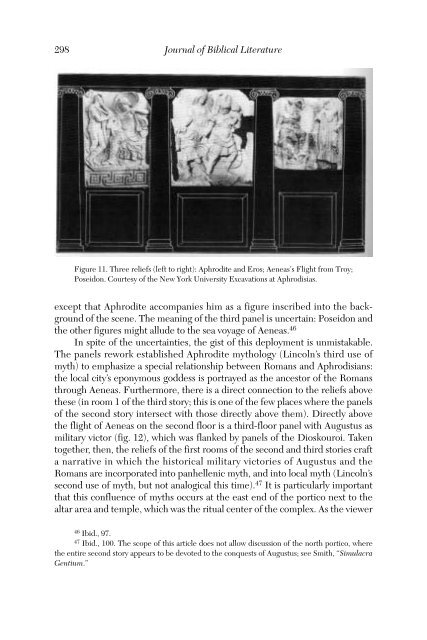Journal of Biblical Literature - Society of Biblical Literature
Journal of Biblical Literature - Society of Biblical Literature
Journal of Biblical Literature - Society of Biblical Literature
You also want an ePaper? Increase the reach of your titles
YUMPU automatically turns print PDFs into web optimized ePapers that Google loves.
298<br />
<strong>Journal</strong> <strong>of</strong> <strong>Biblical</strong> <strong>Literature</strong><br />
Figure 11. Three reliefs (left to right): Aphrodite and Eros; Aeneas’s Flight from Troy;<br />
Poseidon. Courtesy <strong>of</strong> the New York University Excavations at Aphrodisias.<br />
except that Aphrodite accompanies him as a figure inscribed into the background<br />
<strong>of</strong> the scene. The meaning <strong>of</strong> the third panel is uncertain: Poseidon and<br />
the other figures might allude to the sea voyage <strong>of</strong> Aeneas. 46<br />
In spite <strong>of</strong> the uncertainties, the gist <strong>of</strong> this deployment is unmistakable.<br />
The panels rework established Aphrodite mythology (Lincoln’s third use <strong>of</strong><br />
myth) to emphasize a special relationship between Romans and Aphrodisians:<br />
the local city’s eponymous goddess is portrayed as the ancestor <strong>of</strong> the Romans<br />
through Aeneas. Furthermore, there is a direct connection to the reliefs above<br />
these (in room 1 <strong>of</strong> the third story; this is one <strong>of</strong> the few places where the panels<br />
<strong>of</strong> the second story intersect with those directly above them). Directly above<br />
the flight <strong>of</strong> Aeneas on the second floor is a third-floor panel with Augustus as<br />
military victor (fig. 12), which was flanked by panels <strong>of</strong> the Dioskouroi. Taken<br />
together, then, the reliefs <strong>of</strong> the first rooms <strong>of</strong> the second and third stories craft<br />
a narrative in which the historical military victories <strong>of</strong> Augustus and the<br />
Romans are incorporated into panhellenic myth, and into local myth (Lincoln’s<br />
second use <strong>of</strong> myth, but not analogical this time). 47 It is particularly important<br />
that this confluence <strong>of</strong> myths occurs at the east end <strong>of</strong> the portico next to the<br />
altar area and temple, which was the ritual center <strong>of</strong> the complex. As the viewer<br />
46 Ibid., 97.<br />
47 Ibid., 100. The scope <strong>of</strong> this article does not allow discussion <strong>of</strong> the north portico, where<br />
the entire second story appears to be devoted to the conquests <strong>of</strong> Augustus; see Smith, “Simulacra<br />
Gentium.”

















